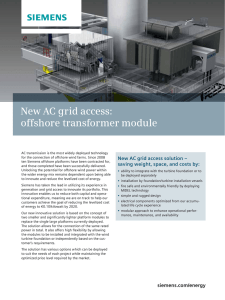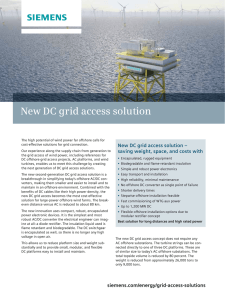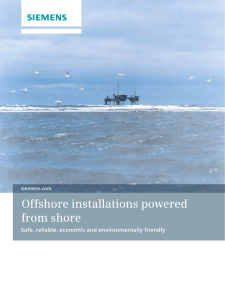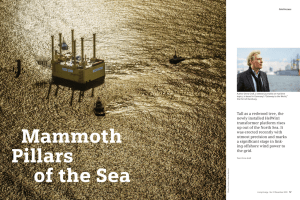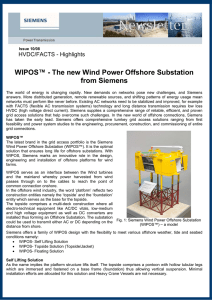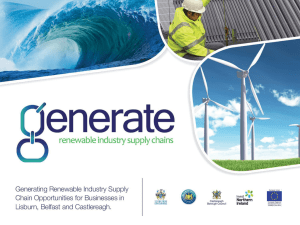Document 10450752
advertisement
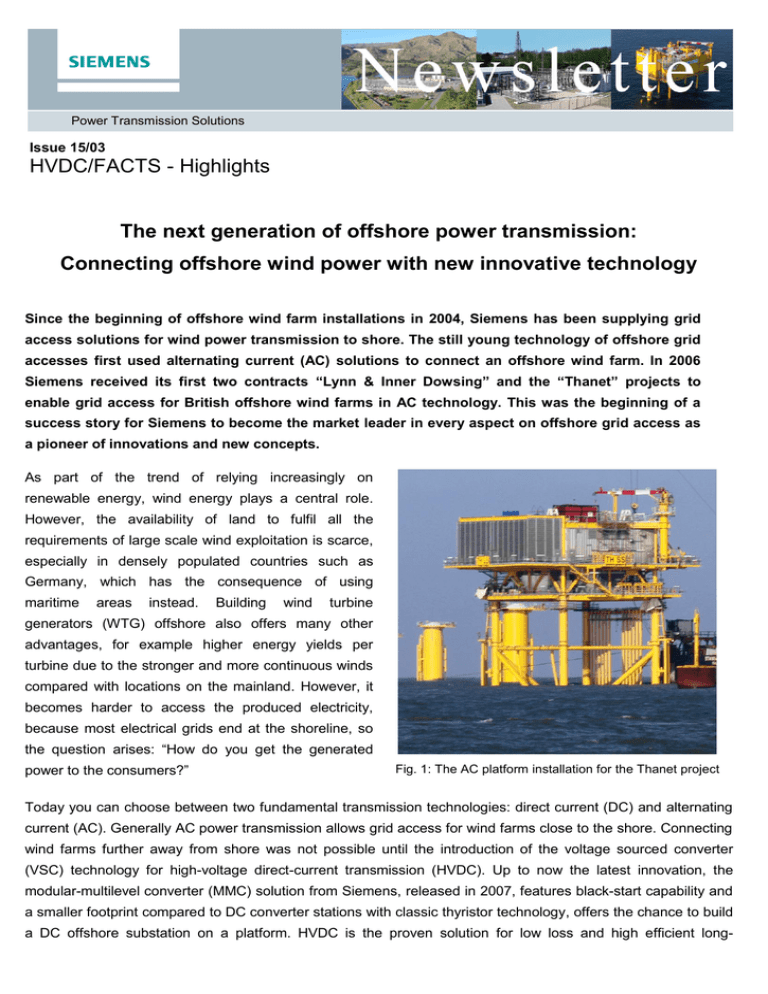
Power Transmission Solutions Issue 15/03 http://www.siemens.com/FACTS http://www.siemens.com/HVDC HVDC/FACTS - Highlights The next generation of offshore power transmission: Connecting offshore wind power with new innovative technology Since the beginning of offshore wind farm installations in 2004, Siemens has been supplying grid access solutions for wind power transmission to shore. The still young technology of offshore grid accesses first used alternating current (AC) solutions to connect an offshore wind farm. In 2006 Siemens received its first two contracts “Lynn & Inner Dowsing” and the “Thanet” projects to enable grid access for British offshore wind farms in AC technology. This was the beginning of a success story for Siemens to become the market leader in every aspect on offshore grid access as a pioneer of innovations and new concepts. As part of the trend of relying increasingly on renewable energy, wind energy plays a central role. However, the availability of land to fulfil all the requirements of large scale wind exploitation is scarce, especially in densely populated countries such as Germany, which has the consequence of using maritime areas instead. Building wind turbine generators (WTG) offshore also offers many other advantages, for example higher energy yields per turbine due to the stronger and more continuous winds compared with locations on the mainland. However, it becomes harder to access the produced electricity, because most electrical grids end at the shoreline, so the question arises: “How do you get the generated power to the consumers?” Fig. 1: The AC platform installation for the Thanet project Today you can choose between two fundamental transmission technologies: direct current (DC) and alternating current (AC). Generally AC power transmission allows grid access for wind farms close to the shore. Connecting wind farms further away from shore was not possible until the introduction of the voltage sourced converter (VSC) technology for high-voltage direct-current transmission (HVDC). Up to now the latest innovation, the modular-multilevel converter (MMC) solution from Siemens, released in 2007, features black-start capability and a smaller footprint compared to DC converter stations with classic thyristor technology, offers the chance to build a DC offshore substation on a platform. HVDC is the proven solution for low loss and high efficient long- Power Transmission Solutions Issue 15/03 HVDC/FACTS - Highlights distances power transmission, whereas the cost-efficient AC solution is the choice for short distances. The decision for an AC or DC solution depends on the project parameters influencing the break-even-point. With respect to the distance to shore the break-even-point varies between 60 kilometers (km) and 140 km. Fig. 2: HelWin1 offshore platform in the North Sea, Germany Currently, AC grid access solutions gather the wind farm’s electrical power in a substation which is located on an offshore platform close to the wind park. The platform is connected to the mainland and its size and capacity depends on the wind farm’s power capacity. For DC grid access small AC platforms gather the WTG’s electrical energy and transfer it to a large central DC converter platform which then transforms the alternating current to direct current and transfers it to the mainland. Considering the number of successfully completed projects with both technologies, Siemens excels as the most reliable contractor for AC and DC grid access solutions. In 2012 the largest offshore wind farm London Array in UK with 630 MW was connected with AC transmission to shore. In January and February, 2015 the DC offshore grid connections BorWin2 and HelWin1, proven in trial operation, were successfully handed over to the operator TenneT as the first worldwide projects of this kind. Based on first experiences with offshore wind farms and the respective grid access solutions, the operators have been confronted with high investment costs in relation to the growth of the wind energy’s share in the energy mix. They set themselves the target to reduce the cost for generation and transmission for wind energy from the current 14.5 eurocents per kilowatt-hour to 10 eurocents by 2020 so that wind power generation will not only be ecologically but also economically beneficial. For that reason Siemens’ engineers have developed new grid access Power Transmission Solutions Issue 15/03 HVDC/FACTS - Highlights technologies through a process of examining the entire production chain of wind energy from the tips of the turbine blades to the electrical sockets of the consumers and reducing anything deemed unnecessary. The result is the largest single cost reduction step for both AC and DC transmissions that has been made so far. For AC transmissions, the result is the offshore transformer module (OTM), a highly compact substation designed to be installed directly onto the foundations of WTGs, which means no additional foundations have to be built. This is enabled by splitting the central substation into two smaller ones connected in series and cutting all unnecessary elements of the substations, reducing it to the core electronics and safety equipment which shrinks the required space significantly. Fig. 3: Offshore transformer module attached to a wind turbine Fig. 4: Comparison of the AC grid access concepts With the new modular space-saving, environmental-friendly and encapsulated offshore components, Siemens is able to reduce the investment costs compared to previous AC offshore grid access solutions particularly for transportation and maintenance. This means large and specialized transportation and installation vessels are not necessary and a typical implementation phase of 24 months (depending on the project), is reduced by three to five months which results in a quicker return of investment. For detailed information: click here. Power Transmission Solutions Issue 15/03 HVDC/FACTS - Highlights In parallel, based on the experiences with DC offshore grid access projects such as BorWin2 and HelWin1 and in cooperation with in-house suppliers for WTGs as well as high- and medium-voltage equipment, Siemens is developing the next generation for DC-offshore grid access, pushing the frontier of technically and economically accessible wind farms further out to sea. Siemens’ aim is to offer robust, compact, environmental-friendly and cost-efficient offshore platforms for DC transmission by 2016 to reach our customer’s target for costreduction. Involved parties such as windturbine generator (WTG) suppliers and regulators are invited to adapt their concepts to this new technology, participating in the economic benefits from Siemens latest innovation. For this new DC grid access solution a software upgrade in the turbine control is required which should not be a challenge for WTG suppliers. Fig.5: New DC platform concept As the market leader in every aspect of wind technology and a pioneer of new technologies and innovative concepts, Siemens has proven itself as a reliable and customer-dedicated company committed to making wind energy the electrical power generation form of the future. Offering state of the art technology for the entire wind energy production chain from the wind turbine generators to the mainland grid access substation, Siemens contributes to the energy revolution making electrical energy renewable and environmentally friendly.
